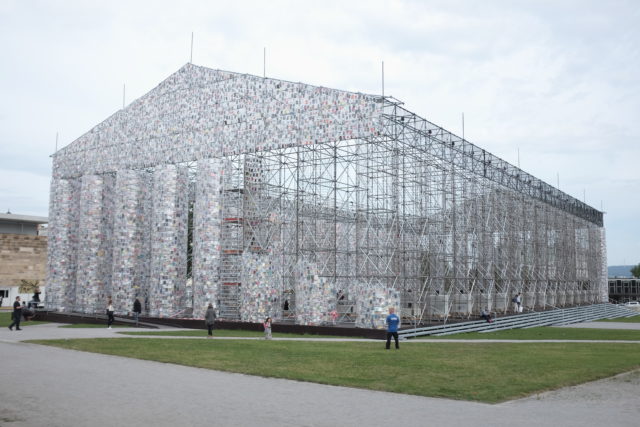
Marta Minujín and Pierre Bal-Blanc, “The Parthenon of Books,” 2016 – ongoing. Photo by Anastasia Tuazon.
You don’t need to go to Kassel, Germany to know that the world seems on shaky ground. But this year’s documenta exhibition, “Learning From Athens,” nails home that idea, nonetheless. That’s quite intentional, given that documenta 14 artistic director Adam Szymczyk, along with a team of more than a dozen curators, chose to stake out a markedly “political” point of view. Though the word “political” can refer to pretty much anything or nothing when it comes to curation, Szymczyk and team have carved out a specific focus: the local is the global. And right now, documenta envisions that the world is in need of being rebuilt entirely—from the ground up.
When national and international coalitions have been unable to prevent the dispersal and death of refugees, a major focus in both the Athens and Kassel editions of documenta, the crisis cannot be remedied by the powers that be. There must be alternatives, and as far as the curatorial through-line goes with documenta 14, those alternatives rely on finding strength in what we have around us. With this void in place, “everything is possible now.” That statement, both powerful and cliche, comes from a video shown in Norwegian artist Joar Nango’s collaborative installation “European Everything” (2017). The text-only video moves at a rapid-fire speed, spitting out bold-Arial font text telling how to reinvent the Norwegian “eskimo,” the indigenous Sami people, by poking fun at Eskimo-brand refrigerators. The video and installation, located in Kassel’s glass pavilion section, is one of the stronger, stranger, and sillier works in Kassel.
Given that this year’s documenta lacks much humor whatsoever, the comedy of refrigerators gives the breathing room necessary to imagine that hope still exists. Indeed, “European Everything” does portray a hopeful dystopia, however constructed out of scrap materials from Athens, built with traditional Norwegian hand-axes, strewn with furs, and covered in knick-knacks. Think Mad Max, but less murder; after all, the video describes how, without the need for electricity, “fridges will be dance floors.” That sounds like a fun party, maybe, but not a world I’d want to live in. Regardless, that world seems near on the horizon when artists like Nango feel compelled to prepare for a time when what once seemed solid (like the EU) might break apart. As you can tell, documenta 14 is about as much fun as waiting for the world to end.
That seriousness is by no means a jab at documenta; a year of dour art is much preferred to, say, last year’s Berlin Biennale, where sleek, post-internet works embraced the gloss and branding of international corporations. In 2017, seriousness of purpose has taken over passive compliance.
Additionally, that seriousness is in keeping with documenta’s reputation for dryly conceptual wall work. That’s not my favorite genre of art making, but thankfully those works tend be found inside the museums and exhibition halls, rather than on the streets, where performances, sculptures, and concerts will continue through the end of documenta in mid-September. At the very least, it’s a new turn for documenta, which deviates from the overbearing conceptualism of its last edition, directed by curator Carolyn Christov-Bakargiev. In the words of critic Roberta Smith, documenta 13 was an “incomprehensible, viewer-defying vastness,” that was “most effective as a disembodied state of mind.” Five years later, documenta 14 may be more targeted in purpose, but the disembodiment, in terms of imaginary projects rather than actual political action, continues. More on that in the commentary and images we’ve compiled below. (Corinna Kirsch)
Photos by Anastasia Tuazon.

Hans Haacke, “Wir (alle) sind das Volk—We (all) are the people,” 2003/2017. Here: located on the corner of a department building off of Friedrichsplatz. Note that above the building’s portico you can see Thomas Schütte’s little-people sculpture, “The Strangers,” (1992), permanently installed at documenta 9.
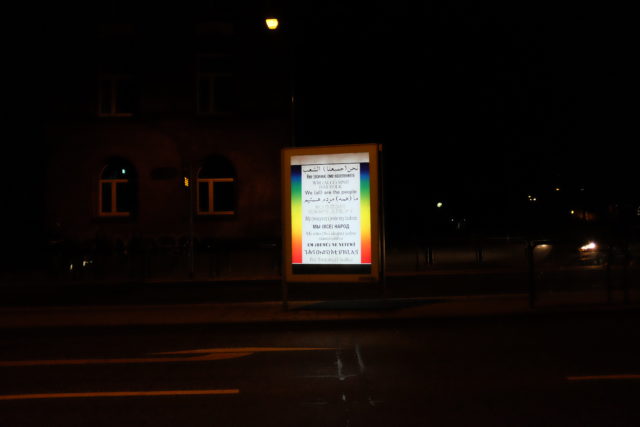
Hans Haacke, “Wir (alle) sind das Volk—We (all) are the people,” 2003/2017. Location: Wienerstrasse tram stop across from the Aral gas station.
Corinna Kirsch: Definitely one of the most noticeable public works at documenta: these rainbow signs are everywhere. The banners and posters show “We (all) are the people” in several different languages. That statement could be a slogan for documenta 14 itself, as so much of the work leans towards upending what it means to be a local, national, or global citizen. It’s an uplifting message to have on a bus stop; on the other hand, it might be a feel-good update to “We are the World,” the 1980s USA for Africa anthem. I sure hope not.
Of course, this is a work by Hans Haacke, whose works of institutional critique, among others, rarely feel straightforward or easy-to-place. They hide as much as they disclose. If there’s a way out of the feel-good-vibes, it’s with the “all” hidden inside the parentheses. Stuck, buried inside a parentheses, “all” is both an afterthought and interlude.
But I’m still conflicted about this work. It’s too open-ended.

Olu Oguibe, “Monument for Strangers and Refugees,” 2017. Location: Königsplatz. Photo by Corinna Kirsch.
Anastasia Tuazon: Haacke’s banners and posters seem to resonate with Olu Oguibe’s massive obelisk. With the phrase “I was a stranger and you took me in” inscribed in a glittery gold color on each of its four sides in English, German, Turkish and Arabic, it heralds a kind of utopian togetherness intended to speak to people of various backgrounds.
Corinna: I wonder if those are the most widely spoken languages in Germany? Regardless, they’re all languages you’re bound to hear or read at some point when you’re here.
This might sound obvious, but like any multicultural state or city, no such reality of “Germanness” or “Americanness” exists any longer. Berlin has nearly as many foreign-born residents as New York City, and as a whole, 10 million people living in Germany come from another country. And those are just the official numbers. This obelisk is a big finger shoved in the face of “Make America Great Again.”
Anastasia: “I was a stranger and you took me in” happens to be a well-known line from the New Testament—but I wasn’t aware of where that phrase came from until another documenta-goer mentioned that to me. It may be well-known, but to whom? Again, like the Haacke work, “Monument for Strangers and Refugees” invites questions of who precisely the “we” and “you” might refer to, or whether the words could ever function as truly open signifiers.
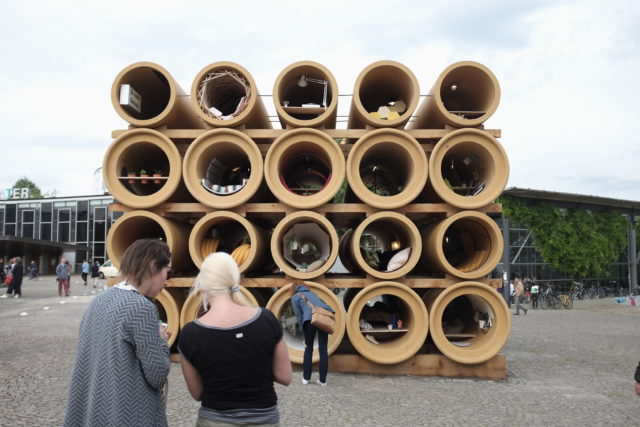
Hiwa K, “When We Were Exhaling Images,” 2017. Located exterior to documenta Halle.
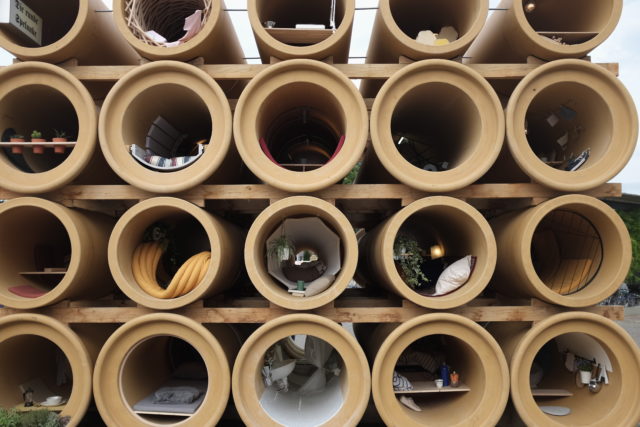
Close-up of Hiwa K, “When We Were Exhaling Images,” 2017
Corinna: So these are micro-housing units that nobody except circular people can live in. But I guess you can hide in them fairly well.
Anastasia: It seems like a sort of pre-fab, post dystopian dwelling. The furniture and objects contained within the pipes don’t appear to be unique or personal to an individual, though the plants make the interiors a bit more inviting, though the plants make the interiors a bit more inviting. It’s kind of reminiscent of Andrea Zittel’s “Living Units,” which are self-contained structures equipped with items to meet the needs of their inhabitants—just much, much more austere.

Regina José Galindo, “El objectivo [The objective],” 2017

Pope. L, “Whispering Campaign,” 2016 – present. Mobile sound performances and installations. Locations: Königstrasse and throughout Kassel.
Corinna: We tried so hard to find one particular location of this performance. We never did, but we tried so hard!
Anastasia: Many performances at documenta are not fixed in a specific location, making it sometimes hard to encounter them, like when we attempted to find Pope.L’s “Whispering Campaign” performance. It was happening somewhere on one of Kassel’s main roads between the rathaus (town hall) and a plaza, but we never saw the people with speakers we were told to look out for.
Corinna: Exactly. According to the official documenta map as well as documenta staff, we were told to look out for people who “may or may not” be carrying a speaker around their neck. We walked up and down the street, but nothing. Point is: don’t rely on the map to find a performance.
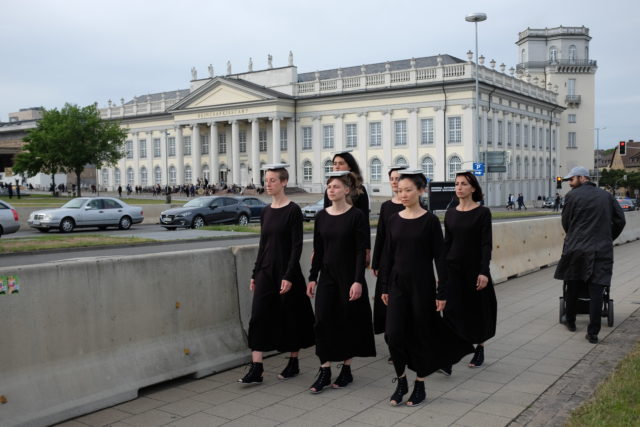
Irena Haiduk, “Spinal Discipline,” 2017. Location: Outside Neue Galerie.
Anastasia: While we couldn’t find that Pope.L performance, we did run into Irena Haiduk’s “Spinal Discipline” shortly after, in which part of the artist’s so-called “army of beautiful women” march together with matching outfits and books by Proust balanced on their heads. Conceptually, I find this piece puzzling—others might find the Proust addition pretentious—but it was a visually arresting sight to come across.
Corinna: Yes, at documenta 14 you’re better off letting the performance come to you, not the other way around.
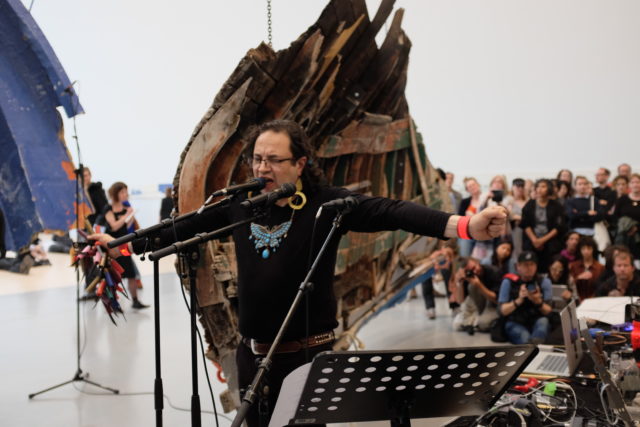
Guillermo Galindo performing “Sonic Borders 2,” 2017.

Galindo’s installation-cum-music-instrument,”Fluchtzieleuropahavarieschallkörper,” 2017.
Anastasia: Galindo, an experimental composer originally from Mexico City, filled the hall with this solo performance, a “sonic ritual” in which he played the strings of massive musical instruments made out of the remains of fiberglass boats. In the performance, bottles full of liquid, a wooden pipe, and a handheld rainbow fan were a few of the objects used to generate sound, and his synthesized vocals added to what struck me as a haunting lamentation on the perilous realities facing migrants. Curator Candice Hopkins writes that Galindo has been developing scores for documenta 14 (in both Athens and Kassel) to function as “odes for border crossers.” Even when he’s not performing, these scores find a material connection in his instruments-as-art-pieces on display in Kassel: they contain remnants from a boat wreckage near Lesbos in which dozens of Turkish refugees drowned.
Corinna: Truly, truly haunting and mesmerizing. By far, Galindo’s performance was the most packed I’d seen: the hall downstairs near where he played was standing-room only; those wishing for a more distant view from above, stood shoulder-to-shoulder in the stairwell to hear him play. His guttural utterances, strengthened by the sonic feedback could have been shaking the walls. You couldn’t make out all the words he screamed, whispered, and barked out, but that didn’t matter. This digital-analog cornucopia of human-animal sounds and repurposed instruments transformed him into an electronic shaman. An apt song for those who have perished at sea. But were “we,” the visitors to documenta Halle, the ones who needed to hear it most? Probably not, but I definitely needed some catharsis given that I have yet to come to terms with this year’s event. Documenta 14, curatorially, seems to waver between as an exploitation of representation as more powerful than action, a sort of art-bubble for cognitive thought. It’s not an exhibition that allows for easy or quick reactions.


Comments on this entry are closed.